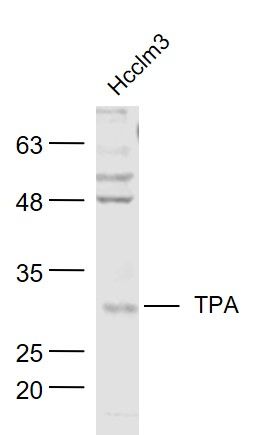产品货号 : mlR17162
英文名称 : TPA
中文名称 : 组织型纤溶酶原激活蛋白抗体
别 名 : TPA Tissue Plasminogen Activator; Alteplase; DKFZp686I03148; Plasminogen activator tissue; Plasminogen activator tissue type; PLAT; Reteplase; t PA; T Plasminogen Activator; t-PA; T-plasminogen activator; Tissue plasminogen activator (t PA); Tissue type plasminogen activator; Tissue-type plasminogen activator chain B; tPA; TPA_HUMAN; TPA1.
研究领域 : 肿瘤 细胞生物 新陈代谢 泛素
抗体来源 : Rabbit
克隆类型 : Polyclonal
交叉反应 : Human, Mouse, Rat, Dog, Pig, Cow, Sheep,
产品应用 : WB=1:500-2000 ELISA=1:500-1000 IHC-P=1:400-800 IHC-F=1:400-800 ICC=1:100-500 IF=1:100-500 (石蜡切片需做抗原修复)
not yet tested in other applications.
optimal dilutions/concentrations should be determined by the end user.
分 子 量 : 59kDa
细胞定位 : 分泌型蛋白
性 状 : Lyophilized or Liquid
浓 度 : 1mg/ml
免 疫 原 : KLH conjugated synthetic peptide derived from human Tissue-type plasminogen activator chain B:401-500/562
亚 型 : IgG
纯化方法 : affinity purified by Protein A
储 存 液 : 0.01M TBS(pH7.4) with 1% BSA, 0.03% Proclin300 and 50% Glycerol.
保存条件 : Store at -20 °C for one year. Avoid repeated freeze/thaw cycles. The lyophilized antibody is stable at room temperature for at least one month and for greater than a year when kept at -20°C. When reconstituted in sterile pH 7.4 0.01M PBS or diluent of antibody the antibody is stable for at least two weeks at 2-4 °C.
PubMed : PubMed
产品介绍 : This gene encodes tissue-type plasminogen activator, a secreted serine protease which converts the proenzyme plasminogen to plasmin, a fibrinolytic enzyme. Tissue-type plasminogen activator is synthesized as a single chain which is cleaved by plasmin to a two chain disulfide linked protein. This enzyme plays a role in cell migration and tissue remodeling. Increased enzymatic activity causes hyperfibrinolysis, which manifests as excessive bleeding; decreased activity leads to hypofibrinolysis which can result in thrombosis or embolism. Alternative splicing of this gene results in multiple transcript variants encoding different isoforms. [provided by RefSeq, Jul 2008]
Function:
Converts the abundant, but inactive, zymogen plasminogen to plasmin by hydrolyzing a single Arg-Val bond in plasminogen. By controlling plasmin-mediated proteolysis, it plays an important role in tissue remodeling and degradation, in cell migration and many other physiopathological events. Play a direct role in facilitating neuronal migration.
Subcellular Location:
Secreted > extracellular space.
Tissue Specificity:
Synthesized in numerous tissues (including tumors) and secreted into most extracellular body fluids, such as plasma, uterine fluid, saliva, gingival crevicular fluid, tears, seminal fluid, and milk.
Post-translational modifications:
The single chain, almost fully active enzyme, can be further processed into a two-chain fully active form by a cleavage after Arg-310 catalyzed by plasmin, tissue kallikrein or factor Xa.
Differential cell-specific N-linked glycosylation gives rise to two glycoforms, type I (glycosylated at Asn-219) and type II (not glycosylated at Asn-219). The single chain type I glycoform is less readily converted into the two-chain form by plasmin, and the two-chain type I glycoform has a lower activity than the two-chain type II glycoform in the presence of fibrin. N-glycosylation of Asn-152; the bound oligomannosidic glycan is involved in the interaction with the mannose receptor.
Characterization of O-linked glycan was studied in Bowes melanoma cell line.
DISEASE:
Note=Increased activity of TPA results in increased fibrinolysis of fibrin blood clots that is associated with excessive bleeding. Defective release of TPA results in hypofibrinolysis that can lead to thrombosis or embolism.
Similarity:
Belongs to the peptidase S1 family.
Contains 1 EGF-like domain.
Contains 1 fibronectin type-I domain.
Contains 2 kringle domains.
Contains 1 peptidase S1 domain.
SWISS:
P00750
Gene ID:
5327
Important Note:
This product as supplied is intended for research use only, not for use in human, therapeutic or diagnostic applications.
产品图片












